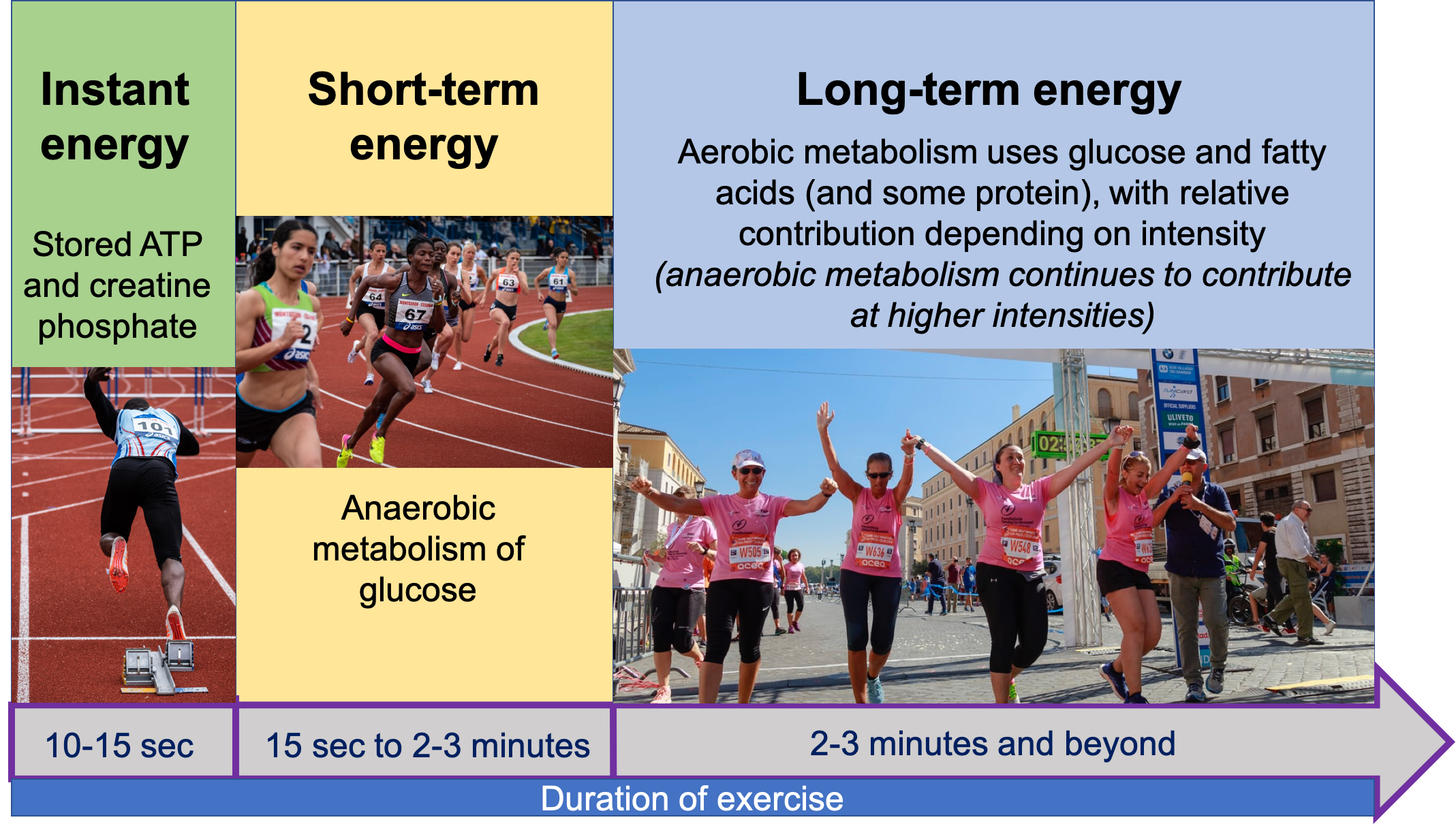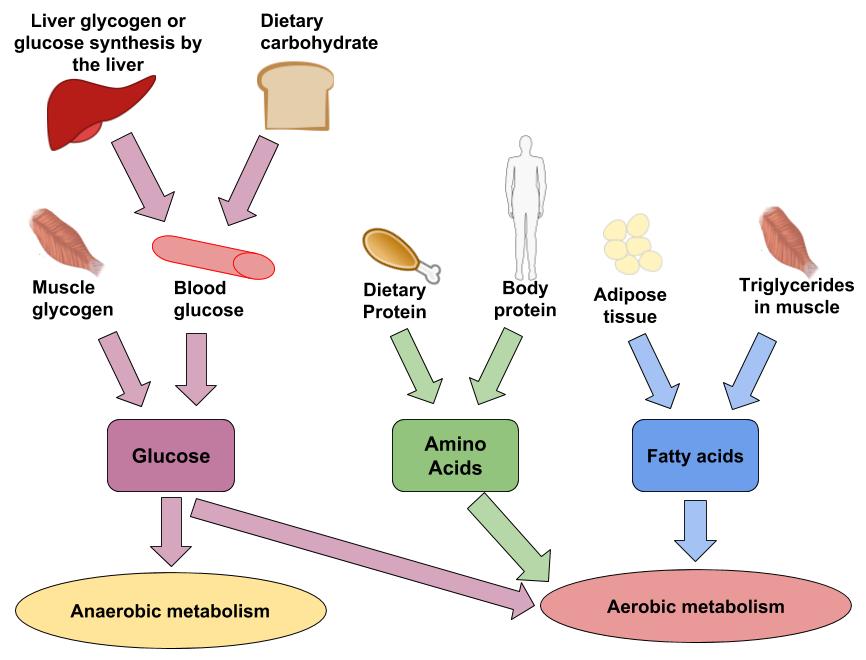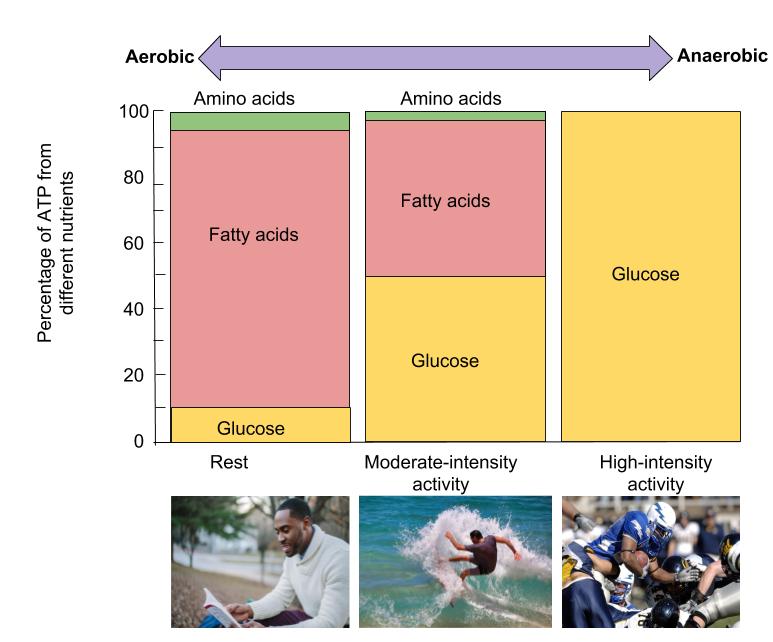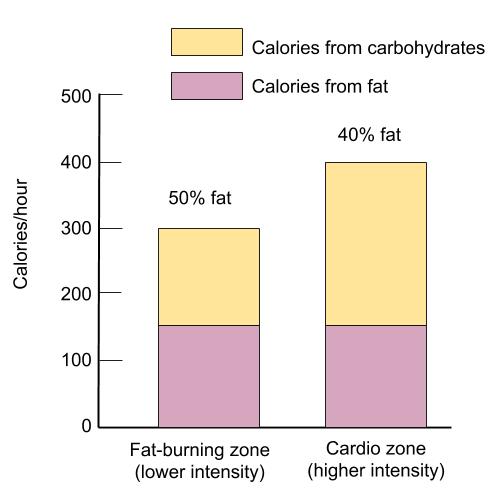64 Fuel Sources for Exercise
The human body uses carbohydrate, fat, and protein in food and from body stores for energy to fuel physical activity. These essential nutrients are needed regardless of the intensity of the activity you are doing. If you are lying down and reading a book or running a marathon, these macronutrients are always needed in the body. However, in order for these nutrients to be used as fuel for the body, their energy must be transferred into the high energy molecule known as adenosine triphosphate (ATP). ATP is the body’s immediate fuel source and can be generated either with aerobic metabolism in the presence of oxygen or anaerobic metabolism without the presence of oxygen. The type of metabolism that is predominately used during physical activity is determined by the availability of oxygen and how much carbohydrate, fat, and protein are used.
Anaerobic and Aerobic Metabolism
Anaerobic metabolism occurs in the cytosol of the muscle cells. As seen in Figure 10.1., a small amount of ATP is produced in the cytosol without the presence of oxygen. Anaerobic metabolism uses glucose as its only source of fuel and produces pyruvate and lactic acid. Pyruvate can then be used as fuel for aerobic metabolism. Aerobic metabolism takes place in mitochondria of the cell and is able to use carbohydrates, protein, or fat as fuel sources. Aerobic metabolism is a much slower process than anaerobic metabolism, but it can produce much more ATP and is the process by which the majority of the ATP in the body is generated.

Figure 10.1. Anaerobic vs aerobic metabolism. Note that carbohydrate is the only fuel utilized in anaerobic metabolism, but all three macronutrients can be used for fuel during aerobic metabolism.
Physical Activity Duration and Fuel Use
The respiratory system plays a vital role in the uptake and delivery of oxygen to muscle cells throughout the body. Oxygen is inhaled by the lungs and transferred from the lungs to the blood, where the cardiovascular system circulates the oxygen-rich blood to the muscles. The oxygen is then taken up by the muscles and can be used to generate ATP. When the body is at rest, the heart and lungs are able to supply the muscles with adequate amounts of oxygen to meet the energy needs for aerobic metabolism. However, during physical activity, your muscles need more energy and oxygen. In order to provide more oxygen to the muscle cells, your heart rate and breathing rate will increase. The amount of oxygen that is delivered to the tissues via the cardiovascular and respiratory systems during exercise depend on the duration, intensity and physical conditioning of the individual.
- During the first few steps of exercise, your muscles are the first to respond to the change in activity level. Your lungs and heart do not react as quickly, and during those beginning steps, they can’t yet increase the delivery of oxygen. In order for our bodies to get the energy that is needed in these beginning steps, the muscles rely on a small amount of ATP that is stored in resting muscles. The stored ATP is able to provide energy for only a few seconds before it is depleted. Once the stored ATP is just about used up, the body resorts to another high-energy molecule known as creatine phosphate to convert ADP (adenosine diphosphate) to ATP. After about 10 seconds, the stored creatine phosphate in the muscle cells is also depleted as well.
- About 15 seconds into exercise, the stored ATP and creatine phosphate are used up in the muscles. The heart and lungs have still not adapted to the increased oxygen need, so the muscles must begin to produce ATP by anaerobic metabolism (without oxygen). Anaerobic metabolism can produce ATP at a rapid pace but only uses glucose as its fuel source. The glucose is obtained from muscle glycogen. At around 30 seconds, anaerobic pathways are operating at their full capacity, but because the availability of glucose is limited, it cannot continue for a long period of time.
- As your exercise reaches two to three minutes, your heart rate and breathing rate have increased to supply more oxygen to your muscles. Aerobic metabolism is the most efficient way of producing ATP; it produces significantly more ATP for each molecule of glucose than anaerobic metabolism. Although the primary source of ATP in aerobic metabolism is carbohydrates, fatty acids and protein can also be used as fuel to generate ATP.

Figure 10.2. Energy systems used to fuel exercise change with duration of exercise. The ATP-creatine phosphate system is used up within seconds. The short-term and long-term systems kick in and provide energy for exercise as the duration of the workout goes on.
The fuel sources for anaerobic and aerobic metabolism will change depending on the amount of nutrients available and the type of metabolism.
- Glucose may come from blood glucose (which is from dietary carbohydrates, liver glycogen, and glucose synthesis) or muscle glycogen. Glucose is the primary energy source for both anaerobic and aerobic metabolism.
- Fatty acids are stored as triglycerides in muscles, but about 90 percent of stored energy is found in adipose tissue. As low- to moderate-intensity exercise continues using aerobic metabolism, fatty acids become the predominant fuel source for exercising muscles.
- Although protein is not considered a major energy source, small amounts of amino acids are used while resting or doing an activity. The amount of amino acids used for energy metabolism increases if the total energy intake from your diet does not meet your nutrient needs or if you are involved in long endurance exercise. When amino acids are broken down and the nitrogen-containing amine group is removed, the remaining carbon molecule can be broken down into ATP via aerobic metabolism, or it can be used to make glucose. When exercise continues for many hours, amino acid use will increase as an energy source and for glucose synthesis.

Figure 10.3. Fuel sources for anaerobic and aerobic metabolism. Both dietary sources and body storage of carbohydrates, fat, and protein can all be used to fuel activity. Amount varies depending on duration and intensity of the activity.
Physical Activity Intensity and Fuel Use
Exercise intensity determines the contribution of different fuel sources used for ATP production. Both anaerobic and aerobic metabolism combine during exercise to ensure that the muscles are equipped with enough ATP to carry out the demands placed on them. The contribution from each type of metabolism depends on the intensity of an activity. During low-intensity activities, aerobic metabolism is used to supply enough ATP to muscles. However, during high-intensity activities, more ATP is needed, so the muscles must rely on both anaerobic and aerobic metabolism to meet the body’s demands.
|
Activity Intensity |
Activity Duration |
Preferred Fuel |
Oxygen Needed? |
Activity Example |
|
Very high |
30 sec – 3 min |
Glucose |
No – anaerobic |
Sprinting |
|
High |
3 min – 20 min |
Glucose |
Yes – aerobic |
Jogging |
|
Low to moderate |
>20 min |
Fat |
Yes – aerobic |
Walking |
Table 10.2. Summary of fuels used for activities of different intensities and durations.
During low-intensity activities, the body will use aerobic metabolism over anaerobic metabolism, because it is more efficient and produces larger amounts of ATP. Fatty acids are the primary energy source during low-intensity activity. With fat reserves in the body being almost unlimited, low-intensity activities are able to continue for a long time. Along with fatty acids, a small amount of glucose is used as well. Glucose differs from fatty acids, because glycogen storages can be depleted. As glycogen stores are depleted, the glucose supply becomes depleted, and fatigue will eventually set in.

Figure 10.4. The effect of exercise intensity on fuel sources. Anaerobic exercise utilizes only glucose for fuel. As activities become more aerobic, the body can utilize fatty acids and, to a small extent, amino acids, for energy production.
One important clarification about exercise intensity and fuel sources is the concept of the fat-burning zone. Many people think that in order to lose body fat, they should exercise at a lower intensity so that fat is the primary fuel source. The fat-burning zone is typically referred to as a low-intensity aerobic activity that keeps your heart rate between 60 and 69 percent of maximum heart rate. The cardio zone, on the other hand, is a high-intensity aerobic activity that keeps the heart rate between about 70 and 85 percent of maximum heart rate. So which zone do you burn the most fat in? Technically, your body burns a higher percentage of calories from fat during a low-intensity aerobic activity. When you begin a low-intensity activity, about 50% of the calories burned come from fat, whereas in the cardio zone only 40% come from fat. However, this isn’t the whole story. High-intensity activity burns more total calories per minute. At this higher rate of energy expenditure, you can burn just as much or more total fat and more total calories as during a lower intensity activity. If weight loss is one of your goals, high-intensity activities will burn more total calories, helping to shift to negative energy balance, and will promote a greater level of fitness. However, the best exercise program is one that is enjoyable, sustainable, and safe for you; if you’re just starting out, it’s wise to begin with low- to moderate-intensity activities and work your way up from there.

Figure 10.5. The fat-burning zone. While a greater percentage of calories burned in lower intensity exercise come from fat, the overall total calorie burn is greater in higher intensity exercise.
Self-Check:
Attributions:
- University of Hawai‘i at Mānoa Food Science and Human Nutrition Program. (2018). Performance Nutrition. Human Nutrition. http://pressbooks.oer.hawaii.edu/humannutrition/chapter/introduction-11/
Image Credits:
- Figure 10.1. “Anaerobic vs Aerobic Metabolism” by Allison Calabrese is licensed under CC BY 4.0
- Figure 10.2. “Energy systems used to fuel exercise change with duration of exercise” by Alice Callahan is licensed under CC BY 4.0, with images: Instant energy sprint photo and short-term energy women on track photos by Nicolas Hoizey; long-term energy race finish photo by Peter Boccia, all on Unsplash (license information)
- Figure 10.3. “Fuel Sources for Anaerobic and Aerobic Metabolism” by Allison Calabrese is licensed under CC BY 4.0
- Table 10.2. “Summary of Fuels” by Tamberly Powell is licensed under CC BY-NC-SA 2.0
- Figure 10.4. “The Effect of Exercise Intensity on Fuel Sources” by Allison Calabrese is licensed under CC BY 4.0
- Figure 10.5. “The Fat-burning Zone” by Allison Calabrese is licensed under CC BY 4.0
The metabolic pathways that require oxygen to generate ATP for cells.
The metabolic system that can generate ATP without oxygen.
A high-energy molecule that can be used to generate ATP for cells during the first 10 seconds of an activity.

